Financial Wellness
Financial Wellness
Household Financial Capability
Annamaria Lusardi, Ph.D., is the founder and academic director of the Global Financial Literacy Excellence Center (GFLEC) at the George Washington University School of Business.
T. Rowe Price recently sat down with Professor Lusardi to discuss some of the research findings in the 2015 National Financial Capability Study (NFCS) and implications for defined contribution plans as they think about financial wellness programs for their employees.
Q. The National Financial Capability Study shows that some segments have low levels of financial literacy. Why is financial literacy so important for financial wellness, and how are different participant segments doing from a financial wellness perspective?
Professor Lusardi: The NFCS is an online survey of more than 25,000 respondents and offers unique information on financial literacy and capability. The data provides a comprehensive view of household finances. We have enjoyed the collaboration with the FINRA Investor Education Foundation, which commissioned the study in consultation with the U.S. Department of Treasury and other federal agencies. Our team at GFLEC has used the data for new research, including research on financial wellness.
As you have mentioned in your question, in the 2015 study, we found that the level of financial literacy in the population is very low. Although individuals have made many financial decisions over their lifetime, even those who are age 50 and over still show low levels of financial literacy. Financial literacy is also low among the young, women, and those with low educational attainment. This matters because financial literacy can be linked to several indicators of financial wellness, including:
- Financial security in the short term, as measured by the ability to deal with short-term “shocks”
- Planning for retirement
- Level of debt and ability to manage debt
Q. You mentioned that millennials and women are particularly vulnerable. Can you talk a bit more about demographic differences in financial fragility, and how this impacts retirement savings?
Lusardi: Financial fragility is a measure that was added to the survey in 2012, and it turned out to be such a good indicator that it was used again in 2015.
This measure assesses the confidence that people have in coming up with $2,000 in 30 days. This question assesses whether people can face a mid-size “shock”—the car breaking down, a child needing braces, unemployment, etc. The question does not ask whether the individual has the money to deal with the shocks, rather it asks about the confidence in coming up with money.
The results are remarkable and speaks of the need for financial wellness programs: 40% of the population was unable to come up with $2,000 in 30 days in 2012, and now a third cannot come up with $2,000 in 30 days. (See figure 1, below.)
FIGURE 1: Financial Fragility
How confident are you that you could come up with $2,000 if an unexpected need arose within the next month?
Note: Percentages may not add up due to rounding.
Source: Financial Capability in the United States 2016, FINRA Investor Education Foundation, July 2016.
Financial Wellness
2016-US-28384
Important Information
This material is provided for informational purposes only and is not intended to be investment advice or a recommendation to take any particular investment action.
The views contained herein are as of November 2016 and may have changed since then.
Information contained herein is based upon sources we consider to be reliable; we do not, however, guarantee its accuracy.
All charts and tables are shown for illustrative purposes only.
T. Rowe Price Investment Services, Inc., Distributor.
